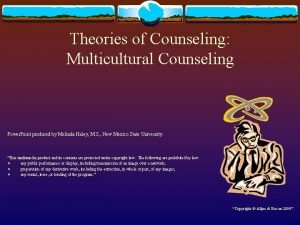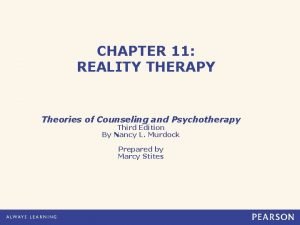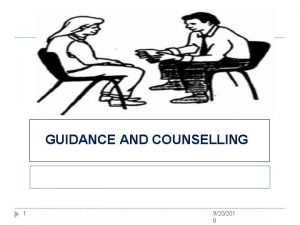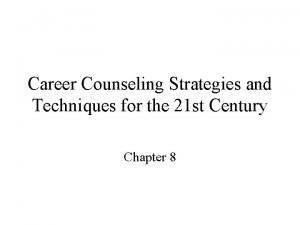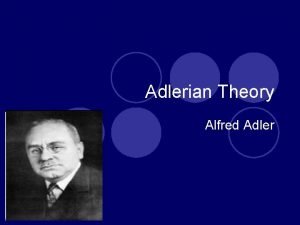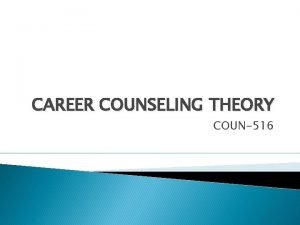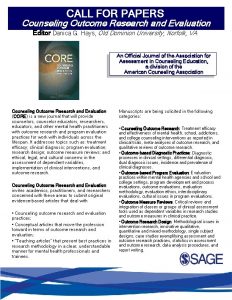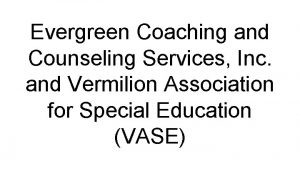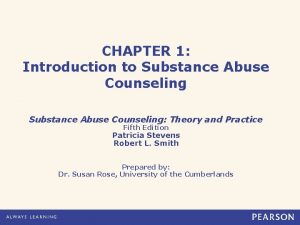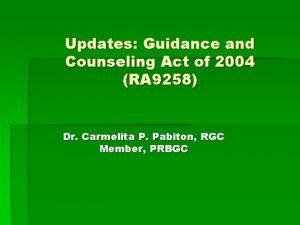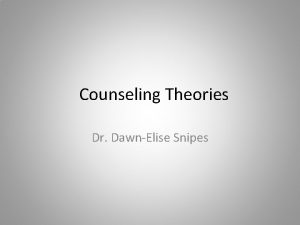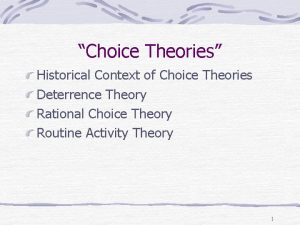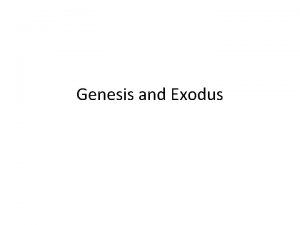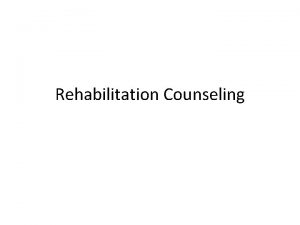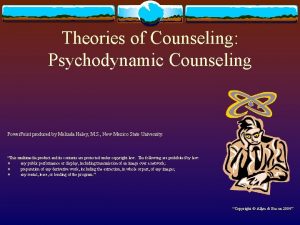CHOICE THEORYREALITY THERAPY COUNSELING THEORIES AND METHODS GENESIS
























- Slides: 24

CHOICE THEORY/REALITY THERAPY COUNSELING THEORIES AND METHODS GENESIS MADURO & MARIANA DA SILVA DECEMBER 1 ST, 2017


CONTEXT • Introduction • View of Human Nature • Choice Theory Explanation of Behavior • Characteristics of Reality Therapy • Therapeutic Process • Application: Therapeutic Techniques and Procedures • Application to Group Counseling • Choice Theory/Reality Therapy From a Multicultural Perspective

INTRODUCTION • Founders: William Glasser and Robert Wubbolding • Problem for most participants is the same: they are either involved in a present unsatisfying relationship or lack what could even be called a relationship • Participants choose their behavior as a way to deal with the frustrations caused by unsatisfying relationships • Choice Theory: theoretical basis for reality therapy, it explains why and how we function • Reality Therapy: provides a delivery system for helping individuals take more effective control of their lives. • Therapy consists: helping and sometimes teaching participants to make more effective choices as they deal with the people they need in their lives • Therapists skills: listener and teacher

VIEW OF HUMAN NATURE • Five Genetically encoded needs that drive us: – Survival or self-preservation – Love and belonging – Power or inner control – Freedom or independence – Fun or enjoyment • Quality world: a file in our minds of the world we would like to live in if we could. It consists of our specific wants and needs. (people, activities, events, beliefs, possessions and situations that fulfill our needs) • Picture album: precise ways to satisfy the specific wants • Part of the reality therapy is assisting participants in prioritizing their wants and uncovering what is more important to them

CHOICE THEORY EXPLANATION OF BEHAVIOR • Total behavior: teaches that all behavior is made up of four components – Acting – Thinking – Feeling – Physiology • “Our behaviors come from the inside and thus we choose our destiny” • Therapist explain to the participants that people do not choose pain and suffering directly, rather it is an unchosen part of their total behavior • Wubbolding: “Behavior is a language and we send messages by what we are doing” • Questions Therapist ask participants: – “What message do you want others to get? ” – What message are others getting whether or not you intended to send them? ”

CHARACTERISTICS OF REALITY THERAPY • Choice theory: the emphasis is on what participants can control in their relationships • Basic Axiom of Choice Theory: – “The only person you can control is YOURSELF” • What do Reality therapists focus on: – Emphasize Choice and Responsibility – Reject Transference – Keep the Therapy in the Present – Avoid Focusing on Symptoms – Challenge Traditional Views of Mental Illness

THE THERAPEUTIC PROCESS • Primary goal: to help participants get connected or reconnected with the people they have chosen to put in their quality world. • Another goal: to help participants learn better ways of fulfilling all of their needs. • Focus: planning and setting both short- and long-term goals. • Therapist Function and role: – Therapy is often considered as mentoring process, Therapist is the teacher and the participants is the student – Teach participants to engage in self-evaluation by asking the question “Is what you are choosing to do getting you what you want and need? ” – Role of therapist is not to make the evaluation but to challenge participants to examine what they are doing – Job of therapist to convey the idea that ”no matter how bad things are, there is hope”

THE THERAPEUTIC PROCESS • Participants Experience in Therapy: – Participants are not expected to backtrack into the past – The emphasis is on action – Participants are challenged – Therapists pose questions such as “Is what you are doing getting you closer to the people you want to be closer to right now? ” – Participants can expect to experience some urgency in therapy. They should be able to say to themselves “I can begin to use what we talked about today in therapy in my life”. • Building a supportive and understanding relationship between the Therapist and Participant is the foundation for effective outcomes. • Personal qualities the Therapist should have: – – – – Sincerity Warmth Congruence Understanding Accepting Respect Openness

APPLICATION: THERAPEUTIC TECHNIQUES AND PROCEDURES • Practice of reality therapy consists of two major components: 1. Creating the counseling environment 2. Implementing specific procedures that lead to changes in behavior • The cycle of counseling for reality therapy: – Begin with creating a working relationship with participants and proceed to an exploration of participants wants and needs – Participants explore their total behavior and make their own evaluation on how effective they are in getting what they want – Decision for new behavior, leads participants to making plans that will lead to change and commitment to it. – The cycle includes follow ups and offering further consultation as needed

THE COUNSELING ENVIRONMENT • Reality therapy rest on the assumption that a supportive and challenging environment allows participants to begin making life changes • Counselors who hope to create a therapeutic alliance strive to avoid: – Arguing – Attacking – Accusing – Demeaning – Blaming – Criticizing – Giving up easily • In this coercions-free atmosphere participants feel free to be creative and to begin to try new behaviors.

PROCEDURES THAT LEAD TO CHANGE ‘’Reality therapists operate on the assumption that we are motivated to change. ’’ 1. When we are convinced that our present behavior is not meeting our needs. 2. When we believe we can choose other behaviors that will get us closer to what we want.

PROCEDURES THAT LEAD TO CHANGE • The mystery out of therapeutic process • Inquire about the choices participants are making in their relationships. • Encourage the participant to focus on what he or she can control • Explores the tenets of choice theory with the participant 1. Identify basic needs 2. Discovering their quality world 3. Help participants understand that they are choosing the total behaviors that are their symptoms.

THE “WDEP” SYSTEM Wants • Wants: to explore their Wants • Do: possible things they can Do • Self- Evaluation: opportunities for Self-Evaluation • Plans: design Plan for improvements Planning WDE P The WDEP system assists people in satisfying their basic needs. Each of the letters refers to a cluster of strategies. W: wants, needs and perceptions D: direction and doing Self. Evaluatio n E: Self-Evaluation P: Planning “These Strategies are Designed to Promote Change” Direction

WANTS • Discover their wants and hopes • Assist the participant in defining what they want from the counseling process and from the world around them • Explore the ‘picture album’ or ‘quality world of the participant. • Questions used in practice to help participants pinpoint their wants: 1. If you were the person that you wish you were, what kind of person would you be? 2. What would you be doing if you were living, as you want to live? 3. Do you really want to change your life? 4. What is it you want that you don’t seem to be getting from life? • Questions that focus on perceptions: 1. How do you look at the situation? 2. Where do you see your control?

DIRECTION AND DOING • Focus on the present is characterized by the key question: What are you doing? – Even though problems may be rooted in the past, participants need to learn how to deal with them in the present by learning better ways of getting what they want. “Reality therapy focuses on gaining awareness of and changing current total behavior” • To accomplish this reality therapist focus on questions such as: – What did you actually do yesterday? – What did you want to do differently this past week? – What stopped you from doing what you said you wanted to do? – What will you do tomorrow? “Rather than focusing on the feelings reality therapist encourage participants to take action by changing what they are doing and thinking”.

SELF-EVALUATION • Is the cornerstone of reality therapy procedures • Asking your participants to evaluate each component of their total behavior is a major task in reality therapy – Does your behavior have a reasonable chance of getting you what you want now? And will it take you in the direction you want to go? – Is your current behavior bringing you closer to people important to you or is it driving you further apart? – Is what you are doing helping or hurting you? – Is it really true that you have no control over your situation?

PLANNING AND ACTION • Once participants determine what they want to change, they are generally ready to explore other possible behavior and formulate an action plan. • Key question: What is your plan? o The plan gives the participant a starting point, a toehold on life, but plans can be modified as needed. o Counselor continually urges the client to be willing to accept the consequences for his or her own choices and action o Plans are designed in terms of how they are likely to affect others in the participants life

SAMIC • To capture the essence of a good plan it must be: – – – Simple Attainable Measurable Immediate, Involved Controlled by the planner, committed to and consistently done. • Participants gain more effective control over their lives with plans that have the following characteristics: 1. 2. 3. 4. 5. 6. 7. 8. The plan is within the limits of the motivation and capacities of the participant Simple and easy to understand Involves a positive course of action and stated in terms of what the participant is willing to do The plan is developed in a way that the participant can carry it out independently of what others do Repetitive and performed daily Is carried out as soon as possible Process- centered activities Evaluate

APPLICATION TO GROUP COUNSELING • Groups provide members with many opportunities for exploring ways to meet their needs through the relationship formed with the group • They can use the group as a place to explore alternative courses of behavior • Feedback from the members and the leader can help individuals design realistic and attainable plans

CHOICE THEORY/REALITY THERAPY FROM MULTICULTURAL PERSPECTIVE • Strengths from a diversity perspective: Ø Principles underlying choice therapy are universal, which makes it applicable to all people Ø Reality Therapy can be adapted Ø It provides participants with tools to make the changes they desire Ø Is an open system that allows for flexibility in application based on the needs of culturally diverse individuals Ø Can be integrated with otherapeutic approaches • Shortcomings from a Diversity Perspective: Ø May not take fully into account some very real environmental forces that operate against them in their everyday lives. Ø Therapist may make the mistake of too quickly or too forcefully stressing the ability of their participants to take charge of their lives Ø Some participants are very reluctant to directly verbally express what they need.

KAHOOT! QUIZ TIME

ROLE PLAY TIME

THANK YOU FOR YOUR AT TENT ION ANY QUESTIONS, COMMENTS AND/OR FEEDBACK?
 Multicultural counseling ppt
Multicultural counseling ppt 11 theories of counseling
11 theories of counseling Counseling vs therapy
Counseling vs therapy Reality therapy in school counseling
Reality therapy in school counseling Good choice or bad choice
Good choice or bad choice Psychoanalytic vs humanistic
Psychoanalytic vs humanistic Bioness bits cost
Bioness bits cost Psychoanalytic therapy is to as humanistic therapy is to
Psychoanalytic therapy is to as humanistic therapy is to Chapter 19 methods of therapy
Chapter 19 methods of therapy Fabrication of wax pattern
Fabrication of wax pattern Guidance
Guidance Missouri comprehensive school counseling program
Missouri comprehensive school counseling program Ksu counseling and psychological services
Ksu counseling and psychological services History of guidance and counselling in the philippines
History of guidance and counselling in the philippines Merits of non directive counselling
Merits of non directive counselling Counseling strategies and techniques
Counseling strategies and techniques Alfred adler theories
Alfred adler theories John crites model of career counseling three factors
John crites model of career counseling three factors Counseling outcome research and evaluation
Counseling outcome research and evaluation 12 core functions of substance abuse
12 core functions of substance abuse Evergreen coaching and counseling
Evergreen coaching and counseling Substance abuse counseling theory and practice
Substance abuse counseling theory and practice Stage one relationship building goals
Stage one relationship building goals Missouri comprehensive guidance and counseling program
Missouri comprehensive guidance and counseling program Guidance and counseling act of 2004
Guidance and counseling act of 2004
